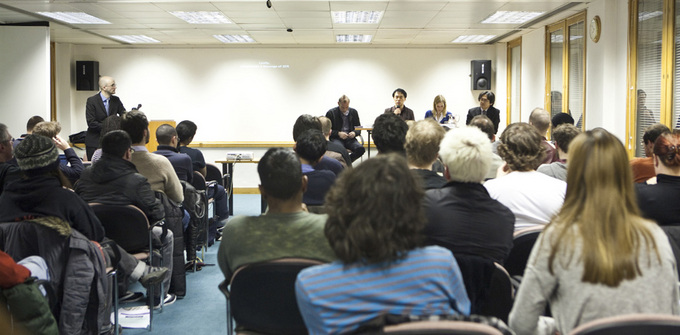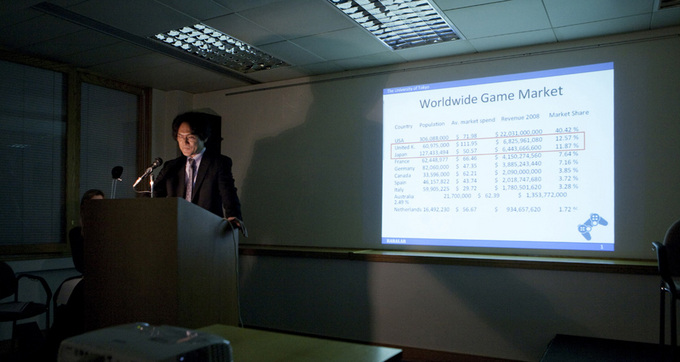Videogames--A Shared Culture Thriving in Japan and the United Kingdom
Akira Baba
Professor, Interfaculty Initiative in Information Studies,
The University of Tokyo
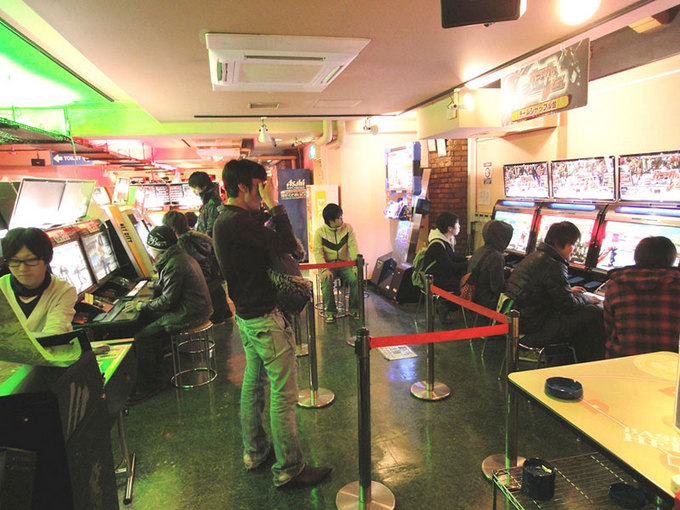
Amusement Arcade / Dick Thomas Johnson
Digging into the cultural context
On February 21 and 22, 2012, the Japan Foundation, London hosted a lecture event on Japanese videogames (known as "TV games" in Japan).
Since the first decade of the 2000s, the Japanese government has been at the forefront of efforts to not only promote but actively market the country's contemporary pop culture and creative industries--such as films, manga, anime, and videogames--around the world. As a result, we began to see a growing number of events promoting one or more of these media art "contents"--as they are called in Japan--as part of the campaign rolled out under the slogan Cool Japan. The government's renewed interest in cultural exports reflects a shift in how media art is being perceived; it has come to be recognized as important intellectual property. And now, the Cool Japan brand has expanded to encompass a much wider range of fields and includes everything from food to fashion.
For those of us studying Japanese media art, the government's new attention to pop culture was a welcome, if belated, move. The fact is, though, we all knew that it had been accepted across the globe since well before the government entered the scene. There are two main aspects of media art products: the economic (commercial benefits) and the artistic (value as works of art).
An excellent example of the commercial value of media art is the Pokémon series. First launched as videogame software in 1996, it became a huge hit among Japanese children. The long-running series that continues to release sequels even today has also spawned a multitude of spinoffs including manga and a television show. With millions of fans not just in Japan but around the world, the Pokémon multimedia franchise is estimated to be worth more than 2 trillion yen, or approximately 25.5 billion US dollars.
The animated feature film Spirited Away is perhaps the best example of media art's artistic aspect. Produced by Studio Ghibli, the film gained worldwide acclaim upon release in 2001, receiving a near-perfect score on a review aggregator website for films. Its high quality and fascinating plot earned numerous film awards including the Golden Bear at the Berlin International Film Festival and the Academy Award for Best Animated Feature Film. In Japan this blockbuster attracted 23.5 million spectators and raked in 30.4 billion yen, setting a box office record yet to be broken.
These are some prominent titles that illustrate the economic and artistic values of our cultural exports, but many different works of media art are now making appearances in various forms worldwide and one of the organizations backing the effort to promote them is, of course, the Japan Foundation.
This effort, however, raises a number of questions that are harder to answer than might be expected: What is the link between these exports and the Cool Japan concept? Are the products really distinctly Japanese and representative of the Japanese culture? It takes much more than tracing the general outlines of a product to provide an insight into these questions. We must discuss the entire cultural landscape of Japan as well as everything that went into creating the work, from the background ideas and concepts to the work practices and production techniques.
A familiarity and understanding of these cultural elements are important prerequisites for a full appreciation of any media art product. Despite this fact, most promotion efforts simply stop at general descriptions and rarely explore significant background information or the production process. The recent two-day lecture on videogames organized by the Japan Foundation London was an ambitious attempt in that it focused less on showing the products and more on digging into the wider cultural context behind the products.
Reaching out to a new audience base
On the first day of the event entitled "Video Games in Japan: Past, Present and Future," I gave a presentation under the title "The Past: Game Over?--How to preserve Video Game Culture and why it is important to do so." In my lecture I stressed that videogames have become a culture and a form of entertainment deeply ingrained in our society, and argued the importance of preserving and utilizing the videogames of the past. Then I went on to discuss the initiative led by the Agency for Cultural Affairs and launched in 2010 to create a videogame archive in Japan. I touched on the on-going work to establish a collection system in the National Diet Library, which is working in collaboration with the Agency and is expected to play a core role in the project. I also pointed out some of the challenges faced in transforming the collection into a comprehensive and organized archive.
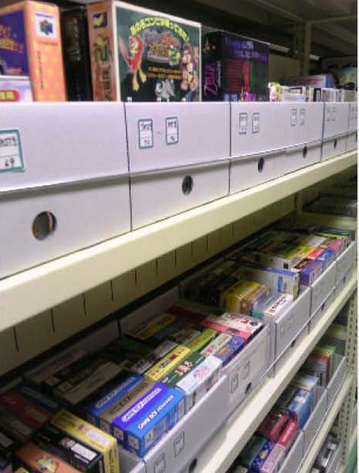
Videogames preserved in the National Diet Library
The United Kingdom is a step ahead of Japan in this area. The National Videogame Archive housed in the National Media Museum is already in operation. Professor James Newman of Bath Spa University, a gaming specialist who is advising the British archive venture, shared some comments with us at the event following my lecture. He highlighted the importance of forging a strong partnership among the videogame industry, government, and academia in order for the archive project to succeed.
I opened the second day with a lecture entitled "Progress to Next Level?--Where is the Japanese Video Game Industry Heading?" in which I summarized the characteristics of the Japanese videogame market. Then Takuma Endo, President of ACQUIRE Corp., a videogame developer, took over to discuss trends and developments in the Japanese market and the aspects of ACQUIRE's products that he considered to be distinctly Japanese. He also talked about the difficulties facing Japanese medium-sized developers and described the various strategies being adopted by ACQUIRE and others in the industry to address these issues.
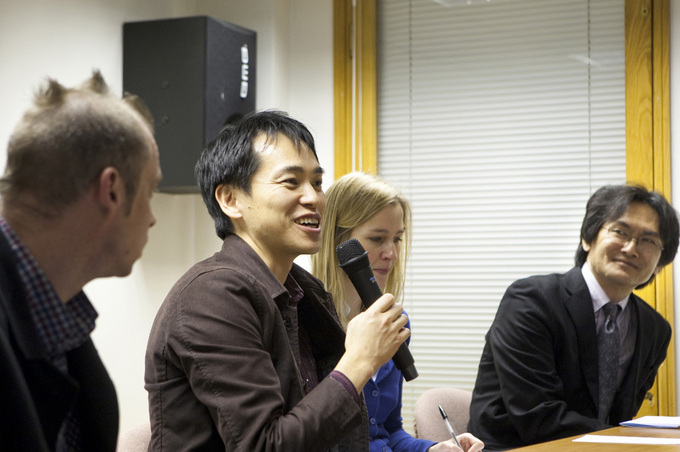
Takuma Endo (Second from left)
ACQUIRE is best known for the Tenchu and Way of the Samurai series, which are both consumer games notable for their Japanese themes and characters like Ninja and Samurai. In recent years the company, a venture firm founded by Endo, has branched out to application software and social games development and is actively seeking opportunities in overseas markets. It is a pioneer among venture-backed videogame start-ups that successfully grew into a medium-sized business. Following Endo's presentation, Steve Boxer, a well-known British games journalist who was on the panel with us, gave us an update on the games scene in the U.K.
Taking a look at the audience surveys, I noticed that our lectures attracted an unusual crowd of participants for a Japan Foundation program; in particular, there were a remarkable number of young people. Our audience was made up primarily of gamers who enjoy playing Japanese videogames, and they came from a variety of fields and backgrounds. There were dojin-game creators (fans or amateurs who create their own works), university students studying game design, and games journalists. Apparently this was not the typical crowd the Japan Foundation, London receives at their events, which goes to show that this program succeeded in reaching out to a new audience base among people who are interested in Japan and its media art. Incidentally, the lecture attracted ample media attention and I gave several interviews including one for the public service broadcaster BBC radio.
The Japanese and British videogame cultures mingle and thrive in harmony
The lecture was unique in that it zeroed in on videogames. There have been quite a few shows and activities on Japanese pop culture that featured manga and anime, but videogames are often left out of the spotlight. That is because, unlike manga and anime, videogames are localized and culturally adapted for the target region before release. As a result, most players do not realize that the games they are playing are Japanese--at least, that's what has been popularly believed.
This event laid that theory to rest. Perhaps the lecture by Endo, whose company ACQUIRE has developed products with distinctly Japanese characteristics, helped underscore Japan's presence in the videogame development scene. At any rate, we realized that British gamers playing Japanese games were well aware of where the games came from, regardless of how famous--or obscure--the titles or the developers were. In my view, that is because the games are imbued with cultural elements that are unmistakably Japanese.
The lecture also took an offbeat approach to the topic. Most screening events or producers' press conferences aim to simply promote the product itself, whereas here, the discussion centered on the creation of a videogames archive and the business strategies of mid-sized developers. At first glance, the archive business would seem to have little to do with the average gamers of today. Works of celebrated creators or developers are much more likely to grab people's interest and attention.
The videogame archive project, which may be an unfamiliar undertaking to many people, is an effort to collect game hardware and software from the past several decades, to organize and classify them, and make them available as resources for research. It is equivalent to a museum or art gallery collecting and displaying old and valuable objects--only this archive will house videogames. It will be a costly and time-consuming affair, which naturally raises the question: are the videogames worth the time and money? We cannot justify the idea of building an archive so long as these games are dismissed as children's toys. The project's success rests on whether we are willing to acknowledge the media as a part of mainstream society and a legitimate culture.
We learned through this event that the debate over whether videogames should be perceived as culture exists in both Japan and the U.K. Videogames have been subjected to criticism and disapproval in both countries. We also learned that all the negative discourse did not stop the gamers and the game industry in the two countries from transforming videogames into a socially accepted mass media.
If there is a conclusion to be drawn from the two-day discussions, it is that videogames have become a culture in Japan and the U.K.--more specifically, a borderless culture. It is a single culture regardless of the differences in genre preferences or player styles and demographics from country to country. The Japanese-made products are accepted in countries abroad precisely because videogames constitute a shared culture that transcends national borders. In the U.K., that acceptance has brought together the Japanese and the British game cultures to mingle and thrive in harmony.
I believe this event will go a long way toward ensuring that Japanese videogames continue to be loved and played in the U.K., which has become the second largest videogames market in the world.
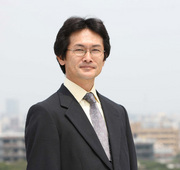 Akira Baba
Akira Baba
Born in 1958 in Ibaraki Prefecture. Baba is a professor at the Interfaculty Initiative in Information Studies, the University of Tokyo. He specializes in historical information studies and content creation science, conducts research on theories and methodologies for creating digital archives of cultural resources, and studies educational applications of digital contents, especially digital games. He served as the first chairman of Digital Games Research Association JAPAN (DiGRA JAPAN) and is a former director of Computer Entertainment Supplier's Association (CESA). Baba gave a lecture at the event on Japanese videogames organized by the Japan Foundation, London in February 2012.
Keywords
- Anime/Manga
- Pop Culture
- Film
- Japanese Studies
- Cultural Policy/Public Diplomacy
- Japan
- U.K.
- The Japan Foundation London
- Videogames
- Contents
- Games
- Cool Japan
- Pokémon
- Studio Ghibli
- Spirited Away
- Berlin International Film Festival
- Academy Award
- The Japan Foundation
- Agency for Cultural Affairs
- National Diet Library
- James Newman
- Takuma Endo
- ACQUIRE Corp.
- Tenchu
- The Way of Samura
- BBC Radio
- Videogame archive
Back Issues
- 2025.6.24 Exclusive Interview:…
- 2025.5. 1 Ukrainian-Japanese I…
- 2024.11. 1 Placed together, we …
- 2024.5.24 The 50th Japan Found…
- 2024.5.24 The 50th Japan Found…
- 2024.5. 2 People-to-People Exc…
- 2024.2.19 Movie Theaters aroun…
- 2024.2.19 Movie Theaters aroun…
- 2023.4.24 The 49th Japan Found…
- 2022.10.24 Inner Diversity <2> …


